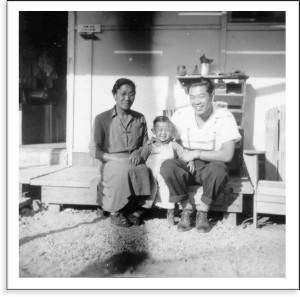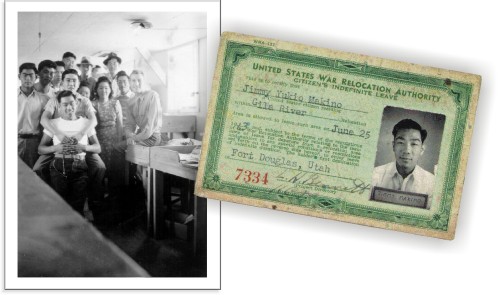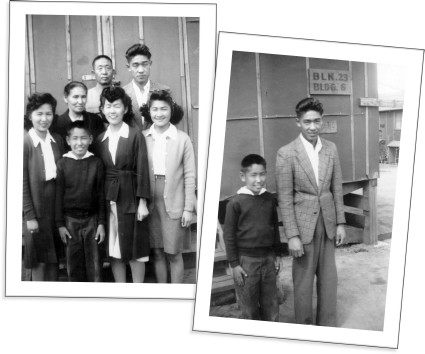![[Aftermath of Pearl Harbor]](pix/makino/sub2.jpg)
The hysteria that followed the bombing of Pearl Harbor and was to lead to the
quarantine of Japanese-Americans in desolate areas away from the coast was made clearer to me by
an event that happened down the street from where my father's market was located. One night, a
passerby noticed a red light illuminating a Japanese face in the otherwise darkened store down
the street from our market. Being a concerned citizen, this person informed the police who arrested
two Japanese-American boys and their father. A Quaker came to the aid of these three jail inmates
and obtained their release after making some inquiries and explaining the situation to the police.
The two boys, it seemed, tended the store with the father. The Japanese face the passerby saw
was one of the boys as he stood by a red light in the store which was attached to a cooler and served
as a monitor that the cooler was working properly. This was only one incident in which the Quakers
helped out Japanese-Americans during those difficult times.
We had about a month or two to prepare for the evacuation to the internment camps whereas some
people in other areas only had a couple of days. We learned about the Relocation Centers through
posters that had been posted and word of mouth. Somebody put the word out that we were going to
a desert-like area. Many of us bought boots in preparation. Other than that we heard nothing
and had no idea what to expect. My father had to leave his business behind for good. One of our
neighbors who we rented our house from took care of some of our things. They had a pretty good
sized basement so they had some room. We never had that much to entrust to anybody anyway.
Some families who "owned" some property were helped out by Quakers who acted as custodians of the
belongings of numerous Japanese-Americans.
We had to report to Tulare Relocation Center. We had no idea how long we were going to be at the
center. Later, when the relocation camps were built, we were taken by troop trains to Gila
Relocation Center in Arizona [Relocation Center was the government euphemism for the internment camps].
Gila was on a Pima Indian Reservation.

Toshiye Makino with her son, Jimmy, and grandson, Roger Ito, in front of their residence.
59-7-C, Gila Internment Camp
 |
Families were kept together in the barracks. Each room was about 20 x 20 feet. I was
housed with my parents. My sister, Helen, lived with her husband, Mary lived with her husband
and small boy, and Ann, who was married around the time of the "evacuation" lived with her
husband as well. We didn't have any visitors - we didn't know anyone in Arizona.
There was a block manager who was in charge of some 200 people. He was the contact person.
He'd go to a bigger meeting and then let us know what he'd heard.
|
There were all sorts of things to do. According to an anniversary book that was put together
for an reunion of Gila internees, 2805 tons of vegetables were harvested at Gila from September
1942 to May, 1943. From this amount, 1464 tons were consumed by the camp and 1341 tons were
shipped to other relocation camps. The chief crops at Gila included: cantaloupe, honeydew,
watermelon, corn, beans, tomatoes, beets, carrots, cucumbers, and squash. First, I tried the
Works Corps, but it didn't work out. I picked cotton. The bag was eight feet long by three or
four feet in diameter. I have short stubby fingers and it was piece work. I only lasted one
day. Then I got work at the camp post office which handled more than a half million dollars in
stamps, money orders and COD's from August, 1942 to May, 1943. It was an 8-5 job and, in
between, I did what I could to have fun like go to dances or the movies. Pay wasn't very good
for work in the camp. The wages were set at $12-, $16-, and $19- a week based on skills
required for the jobs. Doctors and nurses were the sort that got the $19/week pay. It was no
country club, but it wasn't anything like the Nazi concentration camps either. People could
buy things from a camp commissary and through mail order. I was only at the camp for eight
months though so I don't have that much to say about the experience. We had a camp newspaper
which had reprinted an article that summed up the camp
experience pretty well. [Notable residents of the Gila Relocation Camp included character actor,
Noriyuki (Pat) Morita who was eleven years old when interned; and Betty Miiko Shikata
(Miiko Taka in credits) who co-starred with Marlon Brando in the 1950's movie, Sayonara.]
Like I said, I was only in the camp for a short time. When the opportunity was given to us,
I enlisted in the service. My dad was quite upset about me joining the service. He had three
daughters and only one boy. I had to carry on the family name (known in Japanese as
atotori). After I had joined the army, though, my dad finally gave me his blessing.
As it turned out, I never had any boys anyway so my family name dies out with me.
We never had any bitterness about the evacuation and the internment camps, we just went with the
flow. It may have had something to do both with the fact that our parents were immigrants and
Japanese that they taught us not to make waves, that we'd make out.
Sure there were different opinions about fighting for the country. There were maybe a couple of
dozen from Gila who enlisted and a couple of dozen who were drafted. A lot of the Issei made
senninbari, traditional stomach wraps with 1,000 cross stitches, for those of us leaving to join the service.
I didn't keep mine because I didn't think it was right and didn't see any during training.
When those of us who had signed up with the service were leaving the camp at Gila, the "no no"s*
threw rocks and spat at us. [* "no-no Boys" were those interned Japanese-Americans who refused to sign
loyalty oaths during the war. They were called no-no because their answers on two crucial loyalty
questions on a government distributed questionaire were "no".]

(left) Jimmy with co-workers at the Rivers (Gila) Post Office
(right) Pass issued by the War Relocation Authority permitting Jimmy to report for the service at Fort Douglas, Utah
 |
I knew some "no-no boys" from before the war who were sent to Heart Mountain Relocation Camp. One of the boys I knew was sent up to Leavenworth. The day before he was to be released, he was electrocuted to death in some accident. My father was a quiet man and loyal to the U.S., but some Issei openly supported Japan in the war. My uncle, the husband of my paternal aunt, was really gung-ho for Imperial Japan. His family was interned at Manzanar like my wife's family. He renounced his citizenship and the family returned to Japan. They returned to the U.S. after the war. I don't have much contact with them nor do I know what happened to them in Japan. I don't care much. They left the country I was fighting for.

[LEFT] The Kudo Family at Manzanar Internment Camp
(front) Koji
(middle, l-r) Sumiko, Auntie, Fumiko, Mieko
(back) Uncle and Takashi ("Tak")
[RIGHT] Koji and Tak
 |
Kibei were those Nisei who returned to Japan for schooling. My wife's family returned to
Japan sometime around 1939. When the family returned to the U.S., a sister and brother were
left in Japan. The brother was drafted into the Japanese military and sent to Manchuria where he
died. The sister, Sachi, lived in Wakayama throughout the war and saw the pikadon (or
bright flash) of the atomic bomb that dropped at Hiroshima. After the war, Sachi married another
Kibei, Yukata, who had served as a Japanese language instructor for the U.S. military at
the Presidio.
My sisters applied for work furloughs and moved out of the camps to Chicago where they lived for
a couple of years. My parents soon followed.

